Grey squirrel is a tree squirrel in the genus Sciurus. As the name suggests, the grey squirrel has predominantly grey fur, but it can have a brownish color. It has a usual white underside as compared to the typical brownish-orange underside of the fox squirrel. It has a large bushy tail. Particularly in urban situations where the risk of predation is reduced, both white and black-colored individuals are quite often found. Grey squirrels are mainly herbivorous, eating acorns and hazelnuts, berries, fungi and even bark, buds, and shoots.
Squirrels sometimes gnaw on trees as well. They are blessed with a pair of continuously growing incisors. In order to avoid their overgrowth which could cause injuries to them, they need to constantly gnaw on something hard. They strip off the bark which causes unsightly damage to the tree. Grey squirrels damage trees by gnawing at the stem to get to the sweet, sap-filled layers (phloem tissue) just beneath the bark. This tissue is responsible for the movement of sugars around the plant and the process is known as translocation. If this gnawing extends around the stem, the tree is ‘ringed’ i.e. if a complete circle of bark and underlying tissue is removed, then the movement of sugars around the plant will come to a halt and the tree will eventually die. Some of the damaged trees will die; some will succumb to fungal infection. Where the fungus enters, the wood becomes stained and may rot. Callusing commonly found in trees disguises the damage or staining present in the timber at felling age.
The bark stripping usually occurs between late April and the end of July. Very young trees or saplings are generally not attacked as they cannot support the weight of a squirrel, the main stem of older trees are usually safe as the bark is too thick for the squirrels to strip. The most vulnerable trees are sycamore, beech, oak, sweet chestnut, pine, larch and Norway spruce. Bark stripping is a problem in woodland where the squirrel numbers are greater than 5 squirrels per hectare. The risk of damage may be greatest where there are vulnerable trees next to mature woodland that produces a good seed crop, which in turn supports a high density of squirrels.
In many cases, the stems are deformed which reduces the value of the timber. Oak, poplar, Scots pine and Norway spruce are particularly vulnerable to stem breakage.
Such damage caused by these grey squirrels acts as a major disincentive to the planting of broadleaved and coniferous trees for timber as it reduces the value of the final crop. Increasingly wider impacts are being recognized as potentially of major significance to woodland conservation, biodiversity and sustainability. T is also predicted that the damage may lead to a loss of particularly vulnerable species (e.g. beech) within the mature canopy of woodlands and this may be accompanied by loss of associated fungal and invertebrate fauna and their predators. In addition, there may be indirect competition, e.g. for food, between grey squirrels and native fauna. Grey squirrels also carry squirrel pox virus, an infection fatal to red squirrels.
Theories as to why the squirrels go after the bark range from them simply seeking some sweet, sugary sap during summer heat and drought, to the need to continually sharpen their ever-growing teeth, or possibly to obtain the calcium in the sap of the tree phloem tissue needed to satisfy their own calcium deficiencies. Trees growing most vigorously are at increased risk of damage, possibly because they contain more calcium in their sap. It is likely gray squirrels have a requirement for additional calcium during the bark stripping season when adult females are under pressures such as lactation, and juvenile squirrels are going through their main period of bone growth, both of which likely represent a requirement for calcium.
Let us look at the following news article pertaining to the damage caused by grey squirrels.
Squirrels doing bark-stripping damage to trees
Mike Klahr, July 2016, Cincinnati.com, USA
Honey locust trees are a frequent target, possibly because of their sweet sap, although many different species can be attacked
Question: I recently noticed thin strips of bark laying on the ground around the base of my honey locust tree. The bark has been almost totally stripped off large sections of major limbs, leaving bare wood exposed at least halfway around some of the limbs. What could have caused this? What can be done to prevent more damage? Will we lose the limbs that were damaged?
Answer: Unfortunately, the branches that have been debarked more than one-third their circumference will probably die, especially from that point outward. This type of severe bark damage, with thin strips of bark torn off in pieces 1/2 to 1 inch wide, and 2 to 4 inches long, is caused by squirrels.
There is an urgent need for an effective solution against this little four legged mammal which continues to destroy the trees, fruits and vegetables without any sign of repentance.
C Tech Corporation can offer a solution to overcome this problem. Our product Rodrepel™ is a non-toxic, non-hazardous rodent aversive. Combirepel™ is available in the form of solid masterbatches, liquid concentrate and in lacquer form. The product is compliant with RoHS, RoHS2, and REACH and is FIFRA exempted. This product acts through a series of highly developed intricate mechanism ensuring that rodents are kept away from the target application.
The fencing and tree guards can be coated with Combirepel™ to protect the trees, shrubs etc. from the damage caused by the grey squirrels. The product can also be incorporated into agricultural films, greenhouse films, plastic mulches used on a large scale in the agriculture as well as horticulture sector in order to avoid damages caused by these squirrels to fruits and vegetables. Also, the products can be directly incorporated in the polymer matrix during processing of pipes and tubing.Combirepel™ does not leach out, thus there is no soil pollution. Groundwater reserves are also not polluted. Also the non target beneficial species like earthworms, bees etc are not affected.
The product is compliant with ROHS, ROHS2, ISO, REACH, APVMA, NEA, EU-BPR, and FIFRA exempted.
Contact us at technical.marketing@ctechcorporation.com if you’re facing problems with rodents and get best remedies to combat the pest menace.
Also, visit our websites:
http://www.ctechcorporation.com/
http://www.rodrepel.com/
http://www.termirepel.com/
http://www.combirepel.com/
Follow our Facebook pages at:
1] https://www.facebook.com/Combirepel-411710912249274/
2] https://www.facebook.com/Termirepel-104225413091251/
3] https://www.facebook.com/Rodrepel-120734974768048/
Follow us on our Twitter pages at:
1] https://twitter.com/rodrepel
2] https://twitter.com/termirepel
3] https://twitter.com/combirepel

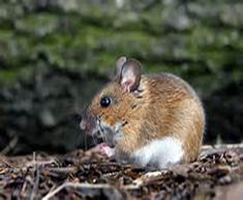 The number of hotels infested by rodents is increasing day by day. The adverse impacts of such invasions by these notorious pests not only affect the hotel owners but also the travelers. Hotels have been facing problems due to rodents since long, but the use of appropriate measures to get rid of them is rarely seen.
The number of hotels infested by rodents is increasing day by day. The adverse impacts of such invasions by these notorious pests not only affect the hotel owners but also the travelers. Hotels have been facing problems due to rodents since long, but the use of appropriate measures to get rid of them is rarely seen.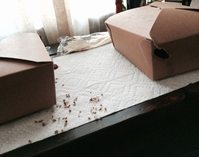 In hotels, specific problem areas include poorly sealed heating and air conditioning ducts.
In hotels, specific problem areas include poorly sealed heating and air conditioning ducts. It is surprising that many are unknown to a rodent called vole which is so widespread and poses a huge potential of causing an extensive damage to trees, lawns and gardens. They have even managed to put the blame for their destructive acts on moles, which do not even eat plants as voles do!
It is surprising that many are unknown to a rodent called vole which is so widespread and poses a huge potential of causing an extensive damage to trees, lawns and gardens. They have even managed to put the blame for their destructive acts on moles, which do not even eat plants as voles do! You can find rats or mice entering your house even when you have designed a rodent-proof house?!
You can find rats or mice entering your house even when you have designed a rodent-proof house?!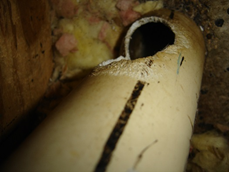 Many a times rodents gnaw on water supply pipes making holes in them. This results in unnecessary flow and wastage of water.
Many a times rodents gnaw on water supply pipes making holes in them. This results in unnecessary flow and wastage of water. A gas leakage is among the most feared human calamities of all time. Be it the poisonous gas leakages, the cooking gas leakages or the petroleum gas leakages. Each and every gas leakage brings with it the insurmountable wreckage of life and surroundings. There is no need to give an introduction into the world of grief provided by gas leakages. Let’s have a look at one such incident.
A gas leakage is among the most feared human calamities of all time. Be it the poisonous gas leakages, the cooking gas leakages or the petroleum gas leakages. Each and every gas leakage brings with it the insurmountable wreckage of life and surroundings. There is no need to give an introduction into the world of grief provided by gas leakages. Let’s have a look at one such incident.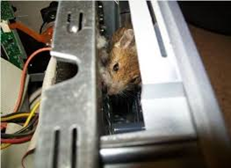 Mandhare said, “The petroleum company has informed us that the rubber tube was bitten by a mouse and had a 2mm hole. Probably, Sunita did not notice the hole. Also, the ventilation in the house was poor as the kitchen window was closed and the door was locked. However, the cylinder and regulator were intact” .
Mandhare said, “The petroleum company has informed us that the rubber tube was bitten by a mouse and had a 2mm hole. Probably, Sunita did not notice the hole. Also, the ventilation in the house was poor as the kitchen window was closed and the door was locked. However, the cylinder and regulator were intact” . In northwestern India, you’ll find the city of Deshnoke, home to a place of worship called the Karni Mata Temple. What’s interesting about this temple — and what makes it a fitting addition to the list — is that it’s positively packed with rats. Some 20,000, in fact. Not only are they welcomed, they’re worshipped.
In northwestern India, you’ll find the city of Deshnoke, home to a place of worship called the Karni Mata Temple. What’s interesting about this temple — and what makes it a fitting addition to the list — is that it’s positively packed with rats. Some 20,000, in fact. Not only are they welcomed, they’re worshipped. Rat Island, part of the Aleutian Islands, is just one example of an island habitat devastated by invasive rats. About 90 percent of the world’s islands have been overrun by rodent stowaways, which can spell disaster for native species especially seabirds.
Rat Island, part of the Aleutian Islands, is just one example of an island habitat devastated by invasive rats. About 90 percent of the world’s islands have been overrun by rodent stowaways, which can spell disaster for native species especially seabirds.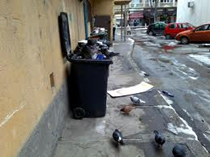 Rats show no respect for famed romantic locales, either. In 2008, Paris officials estimated the city’s rat population had reached 8 million, and since only about 2 million people make their homes in Paris proper, that meant there were about four rats pounding the pavement for every Parisian.
Rats show no respect for famed romantic locales, either. In 2008, Paris officials estimated the city’s rat population had reached 8 million, and since only about 2 million people make their homes in Paris proper, that meant there were about four rats pounding the pavement for every Parisian.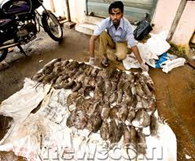 The sprawling metropolis plays host to tens of millions of rats, which carry the disease via their fleas and hence pose a danger to the city’s population.
The sprawling metropolis plays host to tens of millions of rats, which carry the disease via their fleas and hence pose a danger to the city’s population.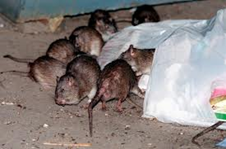 Like many densely populated areas, New York City has a prevalence of rats. Politicians and health authorities actively pursue policies and programs to manage the rat population. The exact number of rats is unknown, but it is estimated that there are at least as many rats as people. The city’s rat population is dominated by the Brown rat and Black rat.
Like many densely populated areas, New York City has a prevalence of rats. Politicians and health authorities actively pursue policies and programs to manage the rat population. The exact number of rats is unknown, but it is estimated that there are at least as many rats as people. The city’s rat population is dominated by the Brown rat and Black rat.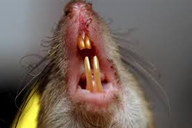 Rats like to live where people live. They quickly adjust to the neighborhood. Rats can thrive on just an ounce of food and water daily, so when they enter a neighborhood and gain access to meat, fish, vegetables, and grains, they will stay. Rats prefer to feed in and around homes, restaurants, and businesses. But they will settle for scraps from trash bags and cans, private yards and what they find at the community refuse disposal and transfer station. Rats get the shelter they need from tall weeds and grass, fences and walls, rubbish piles and abandoned appliances.
Rats like to live where people live. They quickly adjust to the neighborhood. Rats can thrive on just an ounce of food and water daily, so when they enter a neighborhood and gain access to meat, fish, vegetables, and grains, they will stay. Rats prefer to feed in and around homes, restaurants, and businesses. But they will settle for scraps from trash bags and cans, private yards and what they find at the community refuse disposal and transfer station. Rats get the shelter they need from tall weeds and grass, fences and walls, rubbish piles and abandoned appliances.